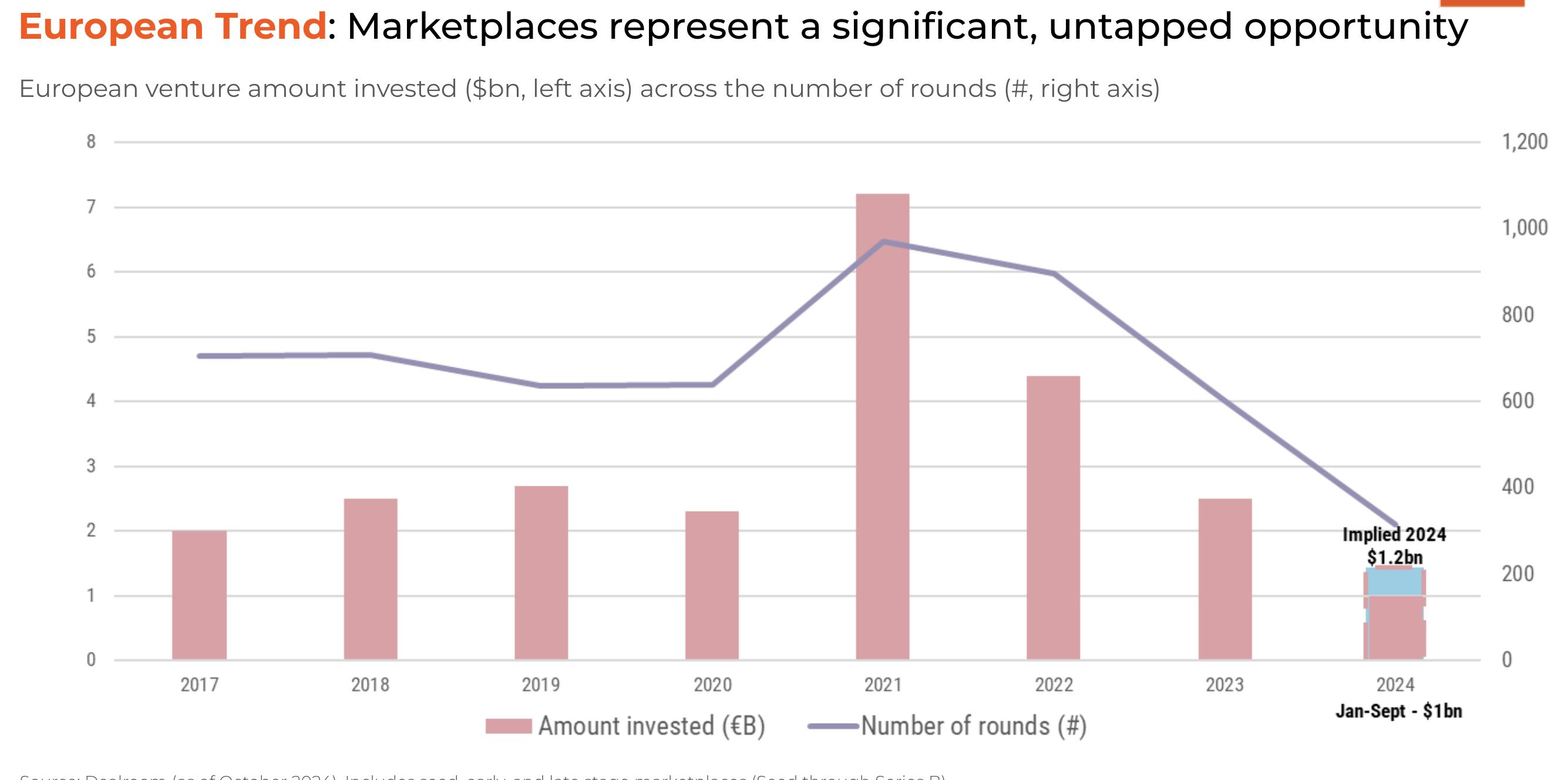How to raise funding for a Sharetribe-powered marketplace
Lessons from 30+ Sharetribe-powered marketplaces that have raised a total of $66M in venture funding.
Published on
Last updated on

For a long while, raising lots of money was necessary for running a successful marketplace. This is no longer the case.
Still, many marketplace founders do dream of raising capital at some point in their journey. When they come across Sharetribe, they sometimes worry that using a SaaS solution as the foundation for their business will make Venture Capitalists (VCs) skeptical.
This worry is understandable, but there's no reason to be worried. Many Sharetribe customers have raised large venture rounds and continue to run their platforms on Sharetribe.
I wanted to learn more about raising funding for a Sharetribe-powered marketplace, so I reached out to founders directly and dug out additional information from public sources. What I discovered:
- 33 founders have raised a grand total of $66M in venture capital for their Sharetribe-powered marketplace.
- Out of them, 12 raised more than $1M.
- The largest individual round was $10M.
- The largest total sum raised by a Sharetribe-powered marketplace was $15M.
- Several more founders raised funding through means other than VC, e.g. government grants, crowdfunding, community grants, and friends and family.
In reality, the total sum of funding raised by all Sharetribe-powered businesses is likely well over $100M, since I could only reach a fraction of the thousands of founders who have launched their marketplaces with Sharetribe over the years.
(I’ve also been strict with which marketplaces count as “Sharetribe-powered”. For example, if a department of Uber used Sharetribe to power a small internal startup—which a team inside Uber considered at one point—I wouldn’t include the $13.2Bn raised by Uber in the total.)
In what follows, I’ll share my analysis of what these founders have in common, and what you can learn from their success to plan your own funding path.
Analyzing the stories of successfully funded Sharetribe-powered marketplaces, I discovered these five lessons that I believe will help many founders better understand how to raise funding for their marketplace:
- Show initial traction.
- Use no-code to get initial traction faster.
- Invest in custom coding where it makes sense.
- Own your intellectual property.
- Choose the right SaaS stack.
Next, some more thoughts on each of these lessons—and a few words on deciding whether raising funding is the right call for your business.
I believe the primary reason most Sharetribe-powered founders succeeded in raising capital was their traction. They were able to concretely show investors that they could effectively match supply and demand. Many had a considerably high GMV before they raised any funding.
The high interest rates of the past years have significantly decreased venture capital, making it objectively more difficult to obtain an investment overall.

If we break this down by marketplaces only, it has been even more challenging. VC investments in marketplaces have yet to bounce back to the same levels as before 2021, as illustrated in the graph below.

Furthermore, investors know that founders have many tools at their disposal to validate their ideas without upfront investment. They want to see something more than an idea and a slide deck.
This gives founders with a strong MVP and solid early signs of traction an edge in the competition. In fact, we often hear stories of founders who initially struggled to raise funding, but when they launched their marketplace and gained their first users, investors became interested.
Of my sample of founders, many (but not all) launched the initial version of their marketplace without coding to validate their business idea.
Marketplaces are some of the most complex websites to build. Airbnb today employs over 1,200 engineers.
At the same time, marketplaces are slower to show traction than traditional startups. Successful founders frequently iterate on their concepts as their business develops.
For example, when I talked to David Oates of Curtsy for Two-sided, the Marketplace podcast, he told me how they pivoted from a peer-to-peer dress rental platform for sorority students in Southern universities in the United States" to a "high-quality thrifting marketplace for women".
This iterative process is much slower (not to mention extremely expensive) if the technology needs to be built from the ground up before any initial validation and learnings are reached. Founders relying on no-code have a considerable advantage in the speed of learning and iteration, which increases their chances of reaching early traction.
All the Sharetribe-powered marketplaces that raised $1M or more had used Sharetribe's developer platform to build functionality unique to their concept with custom code.
This makes perfect sense. At such a scale, a marketplace will very likely need features and workflows that are completely unique to its concept. Custom-building them is the only way to achieve this.
This is a key reason we invested heavily in combining Sharetribe’s no-code builder with a developer platform. The combination ensures that our customers can extend their no-code platform infinitely with code, and build and ship unique functionality really fast. In a sense, they get both the benefits of no-code and the flexibility and scalability of custom development.
A common argument against SaaS-powered startups is that they don’t own their intellectual property (IP), which makes VCs less interested in them.
This is a legitimate concern. On many no-code platforms, anything you build can only be used within the proprietary no-code platform. Essentially, these platforms own their users’ IP.
Sharetribe-powered founders didn’t seem to have had this issue with investors, and I think there’s a clear reason. Our customers do own their IP.
The marketplace essentials that come with Sharetribe’s no-code builder are very similar across platforms. They would be time-consuming to develop from scratch, but even then, they do not form a competitive moat; the basic functionalities needed for a marketplace are very common.
What does represent a competitive advantage is the unique features founders build on top of the essentials.
The way Sharetribe’s developer platform is built ensures that all the custom development work our customers do is completely transferable. If some unforeseen natural disaster wiped Sharetribe off the face of the earth, our customers could keep the custom work they’ve done for their marketplaces and connect it to their own backends.
Furthermore, Sharetribe’s architecture is modular. It’s easy to connect Sharetribe with any other SaaS tool you use to power your business. So, from our customers’ (and their investors’) perspective, Sharetribe is simply one of the many SaaS solutions that power the parts of the business that don’t form critical intellectual property.
The parts that do are created and owned by our customers.
Existing Sharetribe customers have been with us for 5+ years, have hundreds of thousands of users, process millions in payments, and have raised millions in funding.
They have no reason to move away from Sharetribe: our hosted infrastructure continues to provide them with value and save them a lot of time and money, even on a large scale.
So, the question for founders who dream of large-scale funding isn’t whether they can use SaaS or not. It’s about choosing the right tools that let you:
- Get to initial traction quickly and with low initial investment.
- Make your product unique in ways that create real value.
- Guard your true intellectual property.
I couldn’t be happier to learn that Sharetribe has succeeded in building such software for our customers.
Every marketplace business is different, and so is the optimal funding strategy. For many founders, the right path could well be not to raise any funding at all.
There are several examples of successful Sharetribe customers who have bootstrapped their way to success. Mike Williams is a perfect example. He got the idea for Studiotime in one evening in 2015, and built and launched it with Sharetribe the same day, without coding. Six months later, the business was profitable.

How I built a bootstrap marketplace
Mike Williams discussed building and scaling Studiotime all without external funding. Before Mike sold the business, Studiotime was the largest online marketplace for booking music studios.
Mike ran the business for several years, growing it to become the largest global platform for booking a music studio, before selling it successfully in 2021. Today, Mike runs the Everything Marketplaces community, where he helps other marketplace founders achieve similar success.
Venture capitalists are experts in driving growth and generating lucrative exits. Unicorns like Airbnb wouldn’t be where they are today without VCs. At the same time, many marketplace startups have pushed themselves over the edge and into oblivion attempting to obtain the growth demanded by their investors.
Before deciding to raise funding, it’s important to consider carefully if your goals truly align with VCs’ incentives. Here’s an excellent article from our CEO Juho on why you should—and shouldn’t—raise VC for your marketplace.
And if you’re still considering the different funding routes for your marketplace, I recommend starting with this article, which gives a thorough overview of today’s options for founders.
Best of luck with your marketplace business!
More articles for you

Marketplace funding: The complete guide
Struggling with funding your marketplace? This guide helps you decide how much marketplace funding you need – and when and where to source it.

How to bootstrap your marketplace
Can you build a successful marketplace business without funding? Absolutely! Bootstrapping might even help you become profitable faster.

Why raise venture capital for your marketplace – and why not
Should you raise VC funding for your marketplace? If you want to build a unicorn, yes. If you want to get rich – maybe not.
Start your 14-day free trial
Create a marketplace today!
- Launch quickly, without coding
- Extend infinitely
- Scale to any size
No credit card required
